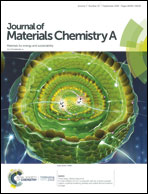Nitrogen-doped hollow carbon nanospheres towards the application of potassium ion storage†
Abstract
Carbon-based materials have triggered significant attention in potassium ion storage as a low-cost and abundant resource. However, the critical step for the commercial application lies in developing environmentally friendly carbon-based materials with high rate capability and long cycling stability as well as promising full-cell performances. Here, nitrogen-doped hollow carbon nanospheres (N-HCNs) were synthesized by nontoxic dopamine as the carbon and simultaneous nitrogen-doping source, exhibiting excellent K+ storage performances with a reversible storage capacity of 154 mA h g−1 at a high current density of 1.0 A g−1 upon 2500 cycles. Moreover, the N-HCNs were successfully assembled in a full-cell battery with TiS2 as the cathode and exhibited high reversible specific capacity, reaching 100 mA h g−1 at 0.1 A g−1 upon 40 cycles. Such a superior K+ storage performance was attributed to the unique structure of the N-HCNs, in which the hierarchical pores facilitated the impregnation of the electrolyte, the hollow structure alleviated the volume expansion, and the doped N atoms increased the conductivity of carbon. Furthermore, detailed electrochemical kinetic calculations manifested that the K+ ion storage in N-HCNs was due to a pseudocapacitive mechanism. The simple synthesis route combined with the remarkable electrochemical performance provides a new insight into green carbon-based anode materials for K+ ion storage with high energy and a long cycling life.



 Please wait while we load your content...
Please wait while we load your content...